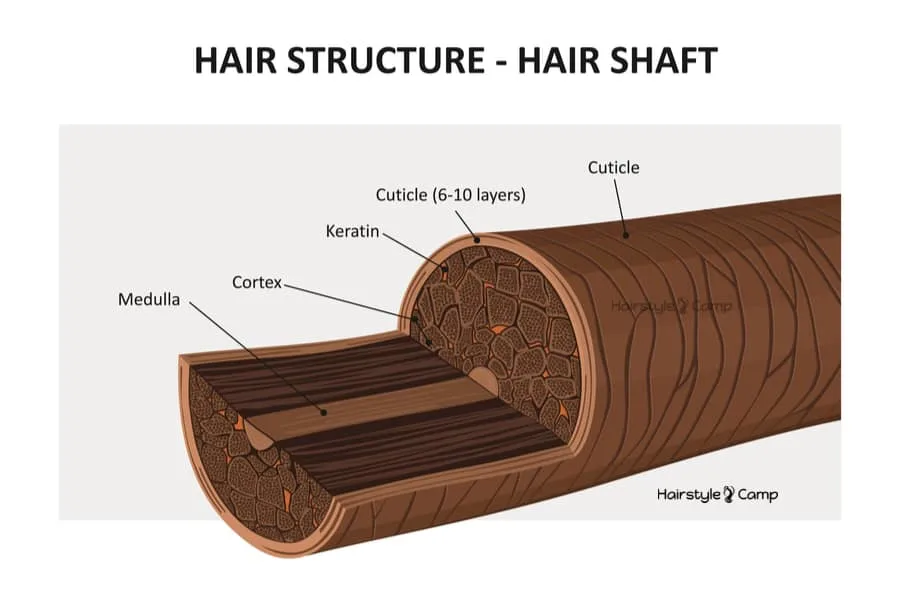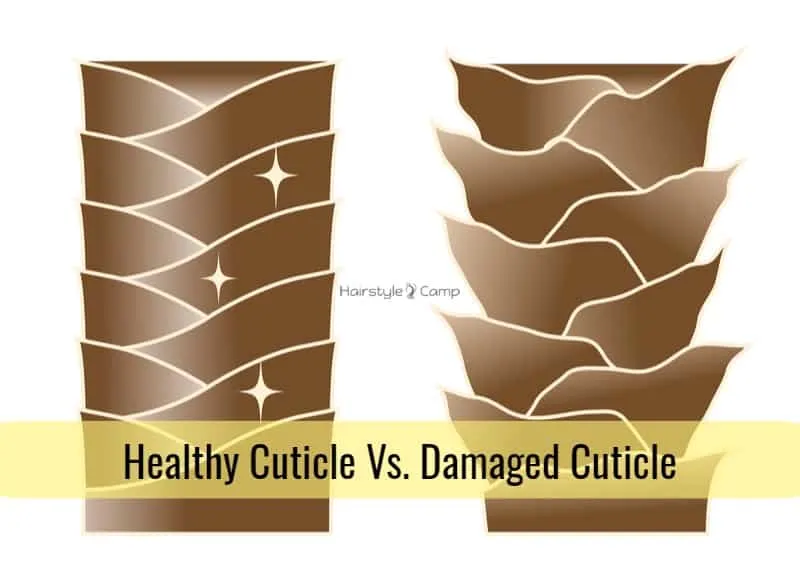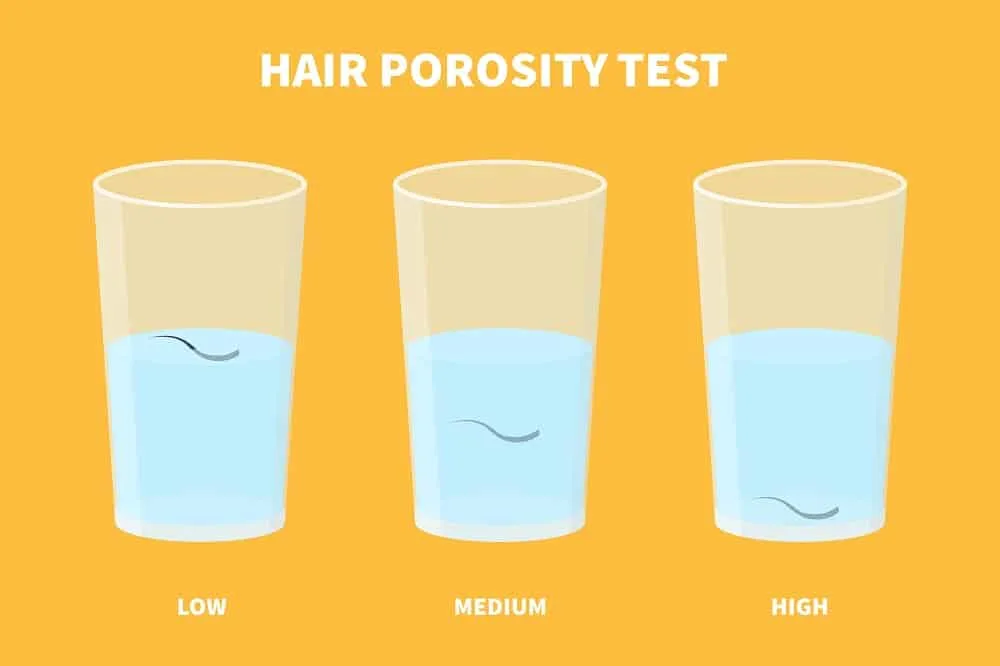Your hair cuticle tells pretty much everything about the health of your hair. Your hair cuticle can make or break the health of your hair, literally.
But what is it, and why does it play such an important role to the health of your hair? First, some myth-busters, because hair follicle and hair cuticle are not interchangeable terms.
What is Hair Cuticle?
The hair cuticle is made up of protein-based, flat hair cells overlapping like the shingles on a roof or the scales on a fish. Because the cuticle is on the surface, it’s the protective layer of the hair shaft.
It’s affected by environmental factors (sun, humidity, water, pollution) and hair products containing harsh chemicals.
Because it is the protective layer, the hair cuticle’s state indicates your hair’s state, in general.

When you move your fingers from top to bottom over a single strand of hair, you’ll notice that it’s smooth. But when you move your fingers from the end of the shaft toward the root, you’ll probably notice that it’s “bumpier.”
It might even make a squeaky sound as your fingers pass over it. That’s because your fingers are moving in the direction of the flattened hair cells of the cuticle layer.
Function
The cuticle is the gateway to the cortex, allowing compounds and chemicals into the inner part of the hair shaft.
Depending on what substance is applied to the cuticle, it will open or close, and the cortex will be nourished and moisturized (or damaged). The cortex is the layer that indicates the natural color, curls, texture, and thickness of the hair itself.
If you suffer from split ends, the protective cuticle has been worn away, and the inner cortex is beginning to fray like the ends of a thread. This condition usually arises when your hair has been treated harshly from brushing too hard or exposure to the elements or chemicals.
Types of Hair Cuticles
Hair cuticles only come in two different types: healthy or damaged.

Your hair’s ability to absorb and retain moisture is determined by the structure of your hair cuticle. Some cuticles don’t absorb and maintain moisture easily, while others absorb moisture quickly but don’t retain it for very long.
Hair Follicle vs. Hair Cuticle

You will see the term hair follicle being used for hair cuticles and vice versa, but they aren’t nearly the same thing. Every hair on your body grows out from a sac-like area at the bottom of your skin’s pores.
That hole is known as a hair follicle, and it is there that a unique cluster of hair reproduction cells is located. Hair follicles are where your hair is formed and sprouts from.
The cuticle, however, is part of the anatomy of an actual hair strand. No matter the texture or length of an individual hair, all hair consists of three layers: the outermost cuticle, the inner cortex, and, in some cases, the medulla below the cortex.
What is a Healthy Hair Cuticle?
A healthy hair cuticle is intact. It has few, if any, shingles missing and guards the hair from mechanical damage and from being over-moisturized or dried out. The cuticle is the gateway to the cortex, allowing compounds and chemicals into the inner part of the hair shaft.
Depending on what substance is applied to the cuticle, it can open slightly to admit them or close, and the cortex will be nourished and moisturized.
Generally, the hair cuticle will open slightly for alkaline substances, like hair conditioners, and close for acidic substances, like apple cider vinegar rinses.
Highly alkaline substances like hair bleach, relaxers, baking soda, and many shampoos open the cuticle so wide that it becomes dislodged. Highly acidic substances, like lemon juice and white vinegar, can corrode the hair cuticle. So it’s best to look for products that are pH balanced.
What is a Damaged Hair Cuticle?
A damaged hair cuticle has missing parts. This could be due to mechanical manipulation, hygral fatigue, high heat, chemicals or all four. A damaged hair cuticle means that anything you put on your hair will reach the inner cortex, which might or might not be a good thing.
For instance, water is a neutral substance. But if your hair gets overloaded with water, it causes the cortex to swell and knock off more cuticle shingles.

High Porosity Hair
This is a nice way of saying hair that is severely damaged. High porosity hair has a lot of gaps in the cuticle. What remains is usually sticking straight up due to chemical processing. This allows it to absorb moisture readily and cause hygral fatigue.
Those same holes enable the moisture to be released too quickly. So the hair swings to the opposite extreme and becomes very dry. Excessive use of heat or chemical treatments can cause highly porous hair.
Low Porosity Hair
Low porosity hair is the healthy cousin of high porosity hair. It has a hair cuticle with fewer holes and densely compacted cell layers. This can make it more challenging to moisturize and hydrate. Low porosity hair is usually a genetically occurring condition with a lot of protein.
How to Open Low Porosity Hair Cuticles?
If you’ve determined that you have low porosity hair, there are several things you can do to open up the cuticle to help your hair stay hydrated:
- Pre-poo your hair with a rich, moisturizing hair mask BEFORE you wash it.
- Don’t over-wash your hair; it strips the hair of its natural scalp oils. Wash no more than once a week.
- Wash your hair with warm-hot water to open the cuticle.
- Use water-based hair products that won’t clog the cuticle.
- Use natural fruit and vegetable oils such as olive, avocado, or jojoba at least once a week.
- Cover your hair while at home and during sleep to retain your scalp’s natural oils.
Medium Porosity Hair
You could say this hair type is the ideal and the best of both worlds. It easily absorbs hydration and retains moisture. But that’s because the cuticle shingles are already partially open.
If they are opened further, they might lose their grip on the hair. Learn more about the differences between high and low porosity hair.
Why Does the Hair Cuticle Get Damaged?
The hair cuticle is the part of the shaft that allows coloring products or hair perm products such as straighteners or curly perms to reach the cortex.
Chemically speaking, an ingredient must be able to lift and penetrate the cells of the cuticle down to the cortex level to change the structure or color of the hair permanently.
Once that happens, though, the effects are irreversible and, in the long run, damaging to the hair. That’s the price of beauty!
Can Damaged Hair Cuticles Be Fixed?
While many products on the market promise to heal or fix damaged hair cuticles, most of them can only temporarily treat the situation. The fact is the only way to repair damaged hair cuticles once and for all is to cut or trim the damaged hair.
Still, there are some things you can do to rejuvenate damaged hair before deciding to cut it. These options come in handy, especially when you want to let your hair grow longer before trimming it.
How to Heal Damaged Hair Cuticles
You can work on your damaged hair to try and stop the damage from taking place as quickly, but there isn’t a way to heal it.
While many products on the market promise to heal or fix damaged hair cuticles, most of them can only temporarily treat the situation by providing a seal over the cuticle. The fact is the only way to repair damaged hair cuticles once and for all is to cut or trim the damaged hair.
Still, there are some things you can do to rejuvenate damaged hair before deciding to cut it. These options come in handy, especially when you want to let your hair grow longer before trimming it.
- Don’t comb or brush it when wet; it causes the strands to stretch and break, leading to damaged cuticles.
- After shampooing, use a deep conditioner and apply a moisturizing leave-in conditioner or frizz-reducing cream or gel.
- Avoid using heat tools like blow dryers, curling irons, and flat irons.
- If you must blow-dry, keep the end of the dryer at least 18 inches from the hair, and use the cool air setting and constant motion.
- Wear your hair in a natural style that can be air-dried instead of blow-dried.
- Don’t bleach, chemically straighten or perm your hair.
- Don’t permanently color your hair; instead, use a temporary wash-out rinse.
- Avoid rubbing your hair vigorously with a towel. This action causes friction and can upset the hair’s cuticle.
- Eat healthy foods that support hair growth and increase hair strength.
- Get your hair trimmed regularly.
- Use high-protein treatment masks that are rich, creamy, and emollient at least once a week.
- Use products with heavier natural oils and butter, such as coconut, argon, and shea.
- Wash your hair with cool-lukewarm water.
- Rinse your hair once a week with apple cider vinegar, which neutralizes the hair’s pH and helps close the cuticle.
Damaged hair cuticles are the primary reason your locks become dry and unmanageable because when they’re open, the cortex is more susceptible to moisture loss and breakage.
Do whatever you can to reduce the external factors that wreak havoc on your hair, and also remember to eat a healthy diet.
FAQs
The outer sheath of each hair strand is the hair cuticle.
Alkaline substances cause the cuticle to open. Very curly hair structures can also mean that the hair cuticle is slightly open on the outside bend of the curl.
It looks like multiple layers of roof shingle.
It’s made of keratin.
There are damaged and undamaged hair cuticles. They will also be arrayed differently depending on how wavy or curly the hair is.
No. It can be sealed with some conditioners like keratin conditioners.
On new hair, the cuticle grows back intact. With certain types of alopecia, however, the cuticle does not regrow.
You can do a hair porosity test to know if your hair is damaged. Set a strand in a glass of water when your hair is clean and free of conditioner.
Wait for five minutes to see whether it floats or sinks. If it sinks, your hair is high porosity, meaning the hair cuticle is damaged.
Unless the bottle states that the shampoo is pH balanced, it is alkaline. So, yes, the shampoo will open the hair cuticle.
Hair cuticles do not close by themselves. You would need a pH-balanced, or slightly acidic product, to close the hair cuticles after washing or performing another alkaline process.
This is why many people use an apple cider vinegar rinse with one part vinegar to seven parts of water.
Combing or brushing the hair while wet causes the most hair cuticle damage, especially if the hair is swollen with water. Heat and corrosive chemicals also cause cuticle damage.
Six to ten layers of cuticle shingles make up the hair cuticle.
There are three different types of hair cuticles on each strand. These are referred to as epicuticle, subcuticle and procuticle.
High porosity hair has a raised cuticle.
The role of the hair cuticle is to protect the more fragile inner layers of the hair.
You can’t fix them, but you can use conditioner to coat them and to help stop the damage from spreading.
It looks hectic–like someone chewed on the hair fiber and left a big hole and threads hanging out. This is how damaged hair looks in many places.
Try trimming your hair regularly to get rid of the damage gradually. Also, leave-in conditioners to help fill in the gaps in your hair cuticle temporarily.
You May Also Like
